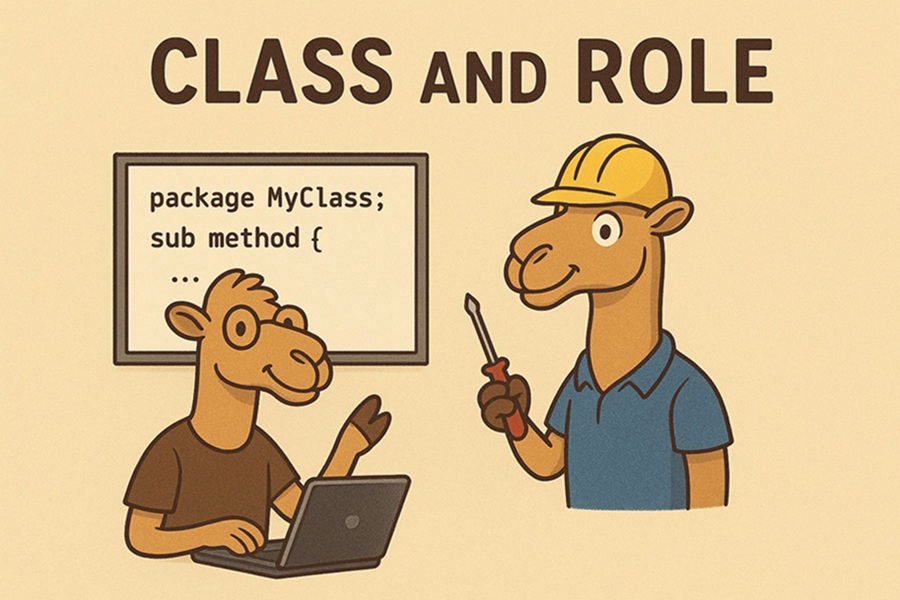DISCLAIMER: Image is generated using ChatGPT.
TL;DR
a) Added Class.pm for lightweight constructors + BUILD hook.
b) Role.pm updated with stricter conflict handling and aliasing.
c) Distribution renamed to Class::Mite, small but mighty.
In my previous post, I introduced Role.pm, a lightweight, dependency-free Role system for Perl. Since then, the project has grown with the addition of a companion module: Class.pm. Together, they form the foundation of the new distribution: Class::Mite.
Why Class.pm?
While Role.pm was designed to bring method composition and requirement contracts into plain Perl, many users asked:
How do I create simple, consistent classes that work seamlessly with these roles?
The answer is Class.pm, a minimal constructor and lifecycle system.
It provides:
a) A new constructor
b) An optional BUILD hook (for initialization logic)
c) Automatic role integration (via with)
d) No dependency chains, just simple Perl.
Example: A Class with a Role
First we create the role Animal.
package Animal;
use Role;
requires qw/speak/;
1;
Then we create the class Animal::Dog taking the role Animal as below:
package Animal::Dog;
use Class;
with qw/Animal/;
sub speak { 'bark!!' }
1;
Action time finally.
use Animal::Dog;
my $dog = Animal::Dog->new;
print $dog->speak, "\n"; # bark!!
Let’s try the default constructor in the class Animal::Dog.
package Animal::Dog;
use Class;
with qw/Animal/;
sub speak { $_[0]->{name} . ' bark!!' }
1;
Let’s test the code now:
use Animal::Dog;
my $dog = Animal::Dog->new(name => 'Dummy');
print $dog->speak, "\n"; # Dummy bark!!
We’ll update the class Animal::Dog to use the BUILD hook.
package Animal::Dog;
use Class;
with qw/Animal/;
sub BUILD {
my ($self, $args) = @_;
$self->{greet} = 'Hello ' . $self->{name};
}
sub speak { $_[0]->{name} . ' bark!!' }
sub greet { $_[0]->{greet} }
Finally test the hook:
use Animal::Dog;
my $dog = Animal::Dog->new(name => 'Dummy');
print $dog->greet, "\n"; # Hello Dummy
Notice how clean this is:
a) new automatically blesses a hash.
b) BUILD runs after construction for custom initialization.
c) with comes directly from Role.pm with zero extra boilerplate.
Updates to Role.pm
Alongside Class.pm, the Role.pm module has also evolved.
Key updates since the last blog post:
1. Automatic Class Base
a) When a class consumes a role, Role.pm ensures the class inherits from Class.pm if it hasn’t already.
b) This gives every role-consuming class a consistent new and BUILD hook.
2. Stricter Conflict Detection
The current release re-aligns with Moo/Moose semantics:
a) If two roles provide the same method, it’s now a fatal error (not silently discarded).
b) Classes win if they already implement the method.
c) Developers can resolve conflicts explicitly with aliasing.
3. Method Aliasing
a) Roles can be applied with renamed methods, allowing you to keep both implementations without conflict.
Why the name Class::Mite?
The distribution is named Class::Mite to capture the spirit of being small but mighty.
a) Small: Tiny codebase, zero dependencies and pure Perl.
b) Mighty: Provides the essential building blocks for both Class and Role.
This naming also aligns with Perl traditions like Mouse and Moo, smaller frameworks inspired by Moose.
Looking Ahead
With Role.pm and Class.pm now bundled together as Class::Mite, the foundation is set:
a) Roles for behavior composition
b) Classes for constructors and lifecycle
c) Clean integration without heavyweight dependencies
ROADMAP
a) More documentation and real-world examples
b) Possibly lightweight utilities for attribute defaults and validation
c) Wider testing across platforms
Purpose and Limits
This project is not intended to replace existing mature object systems such as Moose, Moo, or Mouse. Those frameworks are fully featured, production-proven and battle-tested across countless CPAN distributions.
Class::Mite was created primarily as a prototype for an upcoming project where I needed:
a) A minimal constructor/role system
b) Pure bless objects without sugar or metaclasses
c) Zero external dependencies
If you need rich features like type constraints, attributes, or method modifiers, you should stick with Moose/Moo/Mouse.
If you’re looking for something tiny, dependency-free and easy to embed, Class::Mite may be worth exploring.
Happy Hacking !!!
